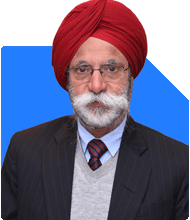How can I invest 1 lac to last 20-25 years in retirement?
Ramalingam Kalirajan |8314 Answers |Ask -Follow
Mutual Funds, Financial Planning Expert - Answered on Oct 22, 2024
He has an MBA in finance from the University of Madras and is a certified financial planner.
He is the director and chief financial planner at Holistic Investment, a Chennai-based firm that offers financial planning and wealth management advice.... more

I am now infront of retirement from local (autonomous) government body by 5 month. Though we are in pension entitled like as stated govt employees but my pension case is now under in law judgment.However for example I have now total corpus 1 lac and my monthly expenses 375.Considering 7%inflation ,I am wanting details financial plan for investing the total corpus to provide my monthly expenses for the period of 20 to 25 years.
Let’s structure a financial plan that focuses on these goals. This will help you sustain your monthly expenses while managing risks and returns.
1. Inflation Consideration (7% Annual Inflation)
Inflation is a key factor in retirement planning. With an inflation rate of 7%, your current monthly expenses of Rs. 375 per Lakh will increase over time. To maintain your lifestyle, your investments must grow faster than inflation.
Therefore, you need to consider investment options that offer both capital appreciation and regular income. Equity mutual funds, debt funds, and hybrid funds can serve this purpose. These funds offer flexibility and cater to your specific financial needs.
However, avoid index funds and direct funds for this phase of life. Index funds follow market trends and may not provide the flexibility needed in retirement. Direct funds require active management, which might not be suitable if you are unfamiliar with monitoring markets. Opting for regular funds managed by a Certified Financial Planner (CFP) ensures expert guidance and timely adjustments to your portfolio.
Key points to remember:
Inflation at 7% will double your expenses in approximately 10 years.
Your investments must provide both growth and safety to beat inflation.
Avoid index funds, as they lack the flexibility to adapt to market changes.
Regular funds with the help of a CFP will ensure your investments are professionally managed.
2. Investment Allocation: Balancing Growth and Safety
Given that your corpus is Rs. 1 lakh, diversifying this amount across various types of funds will provide a balanced approach. The goal is to secure growth while maintaining liquidity to cover your monthly expenses.
You should consider the following fund types:
Equity Mutual Funds: These funds will give you long-term growth. They have the potential to outperform inflation in the long run. However, limit exposure to equity since it carries higher risk. A Certified Financial Planner can help you choose actively managed funds that aim for superior returns.
Debt Mutual Funds: Debt funds provide stability and are less volatile compared to equities. They are ideal for generating regular income. Since they are subject to your tax slab, they are tax-efficient if held for longer periods. Debt mutual funds will be the core of your portfolio for regular income.
Hybrid Mutual Funds: Hybrid funds combine the growth potential of equity with the safety of debt. They offer a balanced approach and are well-suited for retirees. The equity portion helps counter inflation, while the debt portion provides stability. Hybrid funds offer flexibility for rebalancing according to market conditions.
Liquid Funds: These funds offer immediate liquidity and are ideal for emergency expenses. Keep a portion of your corpus in liquid funds to ensure easy access to cash whenever needed. This will act as a buffer for unforeseen situations.
3. Regular Withdrawal Strategy
To manage your corpus efficiently over 20-25 years, you should adopt a systematic withdrawal plan (SWP). This allows you to withdraw a fixed amount from your mutual funds every month. By doing this, you can ensure that your corpus lasts longer, while also providing monthly cash flow.
Here’s how SWP works:
You can set up an SWP with your mutual funds to withdraw Rs. 375 or more per month. The remaining portion of your funds will stay invested and continue to grow.
This method is more tax-efficient compared to withdrawing a lump sum amount.
As your expenses increase due to inflation, you can gradually increase the withdrawal amount.
4. Emergency Fund Allocation
It is essential to keep some funds aside for emergencies. Since your pension is still under legal review, having an emergency fund will give you peace of mind. This fund should be easily accessible, such as through a savings account or liquid fund.
Keep at least Rs. 10,000 aside as an emergency fund.
This will help cover unforeseen expenses like medical bills or sudden repairs without affecting your main investment corpus.
Replenish this emergency fund whenever possible.
5. Health and Medical Coverage
Healthcare costs are a major concern in retirement. Even though you may be entitled to some benefits from your current employment, it is wise to have additional medical coverage.
Ensure that you have a comprehensive health insurance plan that covers hospitalisation and critical illnesses. This will protect your savings from being depleted by medical expenses.
You can use the interest from your debt fund or liquid fund investments to pay for medical insurance premiums, ensuring that your medical needs are covered without dipping into your principal corpus.
6. Reinvestment of Surplus Funds
As your investments grow, there will be times when you may have surplus income after covering your monthly expenses. This surplus should be reinvested to continue building your corpus.
Any excess income from your SWP can be reinvested in debt funds to ensure that your corpus grows steadily.
Reinvesting helps to extend the life of your corpus, making it last for 20-25 years or more.
7. Tax Planning
Tax efficiency is essential to maximize your retirement income. Different types of mutual funds are taxed differently.
Equity mutual funds: Long-term capital gains (LTCG) above Rs. 1.25 lakh are taxed at 12.5%. Short-term capital gains (STCG) are taxed at 20%. Holding equity funds for the long term ensures lower tax liability.
Debt mutual funds: Debt funds are taxed based on your income slab. However, holding them for a longer period reduces the tax impact, making them a viable choice for retirees.
By opting for a combination of equity and debt mutual funds, you can manage your tax outgo efficiently while maintaining steady income.
8. Reviewing and Rebalancing Your Portfolio
Once you set up your investment plan, it is important to review it regularly. Markets and inflation will fluctuate, and your portfolio must adapt to these changes.
Review your portfolio every six months with the help of a Certified Financial Planner.
Rebalance your investments based on market conditions and your changing needs. This could mean shifting from equity to more debt as you age, or vice versa if inflation accelerates.
Regular rebalancing ensures that you stay on track with your financial goals while keeping your risk exposure manageable.
Final Insights
Securing your retirement requires careful planning and a strategic approach to investing. With Rs. 1 lakh, you need to focus on both capital appreciation and stability. A diversified portfolio of equity, debt, hybrid, and liquid mutual funds will ensure steady income while preserving your corpus for the long term.
Avoid index and direct funds, as they may not offer the flexibility and active management you need at this stage. Instead, work with a Certified Financial Planner who can guide you in selecting the best regular funds and help you set up a systematic withdrawal plan.
By following this plan, you can ensure that your retirement is financially secure and that your monthly expenses are covered for the next 20-25 years. Regular reviews and rebalancing, along with careful tax planning, will further enhance the longevity of your investments.
Best Regards,
K. Ramalingam, MBA, CFP,
Chief Financial Planner,
www.holisticinvestment.in
https://www.youtube.com/@HolisticInvestment
You may like to see similar questions and answers below
Ramalingam Kalirajan |8314 Answers |Ask -Follow
Mutual Funds, Financial Planning Expert - Answered on May 17, 2024
Ramalingam Kalirajan |8314 Answers |Ask -Follow
Mutual Funds, Financial Planning Expert - Answered on Jan 02, 2025
Milind Vadjikar |1199 Answers |Ask -Follow
Insurance, Stocks, MF, PF Expert - Answered on Apr 29, 2025
Ramalingam Kalirajan |8314 Answers |Ask -Follow
Mutual Funds, Financial Planning Expert - Answered on Apr 29, 2025
Ramalingam Kalirajan |8314 Answers |Ask -Follow
Mutual Funds, Financial Planning Expert - Answered on Apr 29, 2025
Ramalingam Kalirajan |8314 Answers |Ask -Follow
Mutual Funds, Financial Planning Expert - Answered on Apr 29, 2025
Mayank Chandel |2248 Answers |Ask -Follow
IIT-JEE, NEET-UG, SAT, CLAT, CA, CS Exam Expert - Answered on Apr 29, 2025
T S Khurana |458 Answers |Ask -Follow
Tax Expert - Answered on Apr 29, 2025
T S Khurana |458 Answers |Ask -Follow
Tax Expert - Answered on Apr 29, 2025
T S Khurana |458 Answers |Ask -Follow
Tax Expert - Answered on Apr 29, 2025
T S Khurana |458 Answers |Ask -Follow
Tax Expert - Answered on Apr 29, 2025
Prof Suvasish Mukhopadhyay |600 Answers |Ask -Follow
Career Counsellor - Answered on Apr 29, 2025























